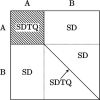Toward a Stochastic Complete Active Space Second-Order Perturbation Theory
- PMID: 38154124
- PMCID: PMC10788896
- DOI: 10.1021/acs.jpca.3c05109
Toward a Stochastic Complete Active Space Second-Order Perturbation Theory
Abstract
In this work, an internally contracted stochastic complete active space second-order perturbation theory, stochastic-CASPT2, is reported. The method relies on stochastically sampled reduced density matrices (RDMs) up to rank four and contractions thereof with the generalized Fock matrix. A new protocol for calculating higher-order RDMs in full configuration interaction quantum Monte Carlo (FCIQMC) has been designed based on (1) restricting sampling of the corresponding excitations to a deterministic subspace, (2) averaging the RDMs from independent dynamics and (3) projecting them onto the closest positive semi-definite matrix. Our protocol avoids previously encountered numerical conditioning problems in the orthogonalization of the perturber overlap matrix stemming from numerical noise. The chromium dimer CASSCF(12,12)/CASPT2 binding curve is computed as a proof of concept.
Conflict of interest statement
The authors declare no competing financial interest.
Figures






References
-
- White S. R.; Martin R. L. Ab initio quantum chemistry using the density matrix renormalization group. J. Chem. Phys. 1999, 110, 4127–4130. 10.1063/1.478295. - DOI
-
- Marti K. H.; Reiher M. The Density Matrix Renormalization Group Algorithm in Quantum Chemistry. Z. Phys. Chem. 2010, 224, 583–599. 10.1524/zpch.2010.6125. - DOI
-
- Legeza O.; Roder J.; Hess B. QC-DMRG study of the ionic-neutral curve crossing of LiF. Mol. Phys. 2003, 101, 2019–2028. 10.1080/0026897031000155625. - DOI
LinkOut - more resources
Full Text Sources

